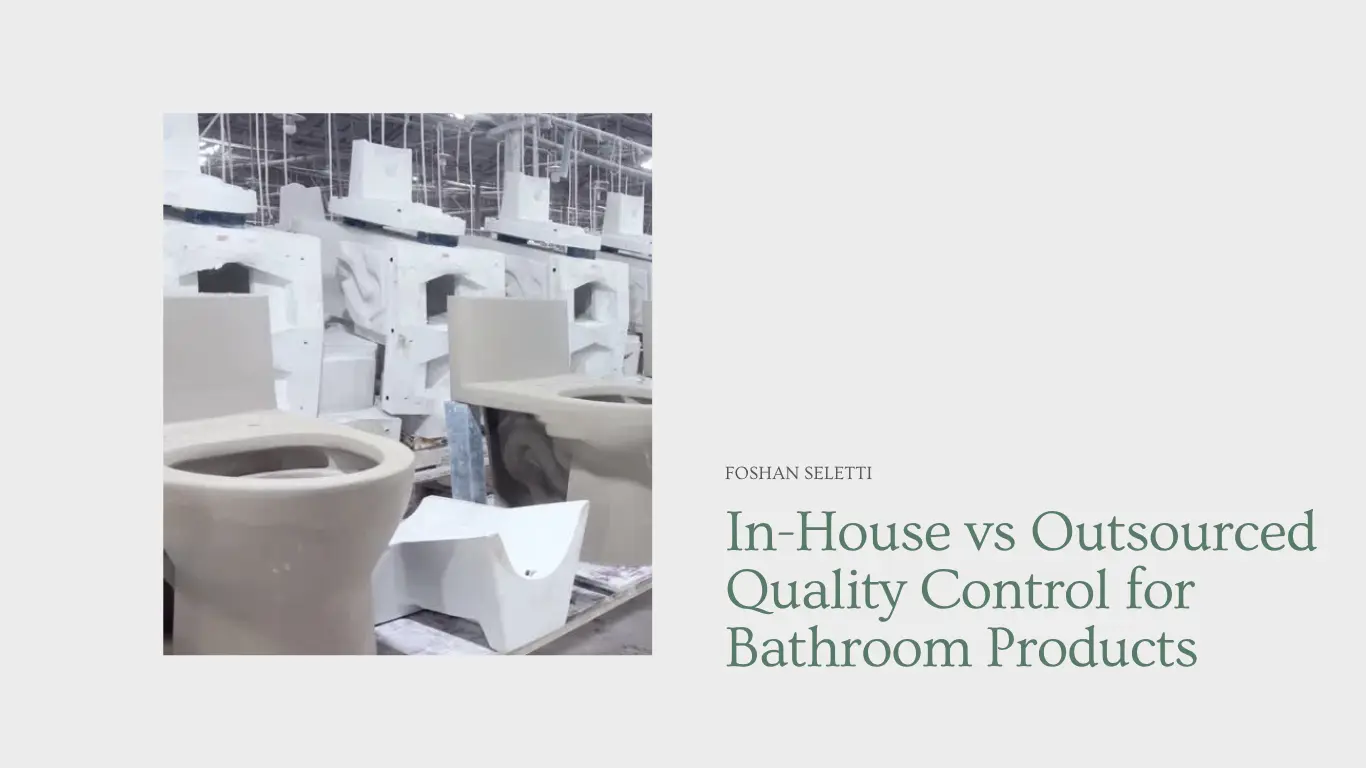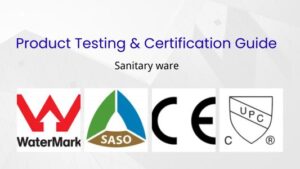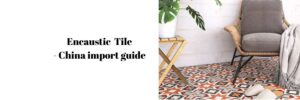Introduction
Quality control failures in bathroom products can be devastating—leaky toilets, cracked basins, and compliance violations don’t just result in costly returns, they can destroy supplier relationships and damage brand reputation. For importers and procurement managers sourcing from China, the question isn’t whether quality control matters, but how to implement it effectively.
The debate between in-house **bathroom product quality control** versus outsourced inspection services has become increasingly critical as manufacturers face tighter budgets and stricter compliance requirements. Both approaches offer distinct advantages: in-house teams provide deep product knowledge and direct oversight, while third-party inspectors bring objectivity and specialized expertise in drainage efficiency, impact resistance, and certification standards.
At Seletti, we’ve worked with importers who’ve experienced both approaches firsthand. Some clients initially relied on factory promises alone, only to face significant quality issues upon arrival. Others invested heavily in building internal QC teams but struggled with consistency across multiple suppliers. This guide examines the real-world trade-offs between cost efficiency, reliability, and compliance to help you make an informed decision that protects your business and ensures consistent product quality.
Looking for the Perfect Toilet for Your Bathroom?
Explore our diverse range of toilets designed to fit any bathroom style and size. Featuring eco-friendly options with dual flush systems, our products promise efficiency and reliability.
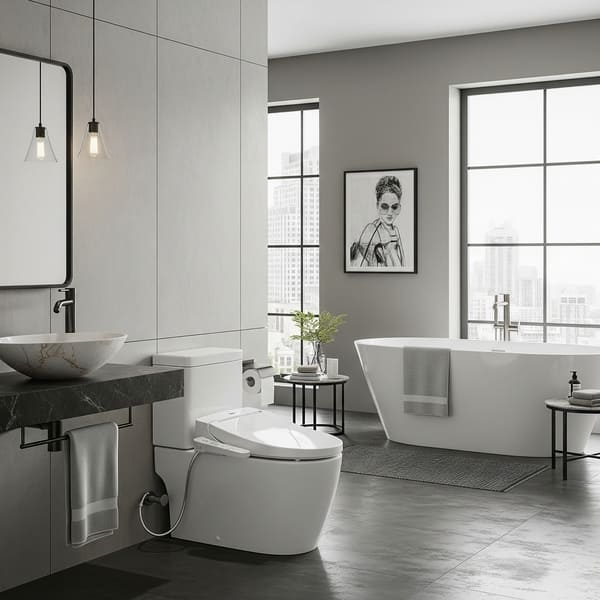

The Critical Decision – In-House vs Outsourced Quality Control for Bathroom Products
For bathroom product manufacturers, choosing between in-house and outsourced quality control can make or break your business reputation. This decision impacts everything from production costs to customer satisfaction, yet many companies rush into it without proper analysis.
At Seletti, we’ve witnessed firsthand how manufacturers struggle with this choice. Some clients came to us after facing significant quality issues when they relied solely on factory promises without structured bathroom product quality control systems in place.
“The choice between in-house and outsourced quality control for bathroom products depends on your production volume, technical expertise, and long-term business strategy.”
Why Quality Control Strategy Matters for Bathroom Products
Bathroom products face unique challenges that standard manufacturing quality control doesn’t address. Water resistance, drainage efficiency, and surface durability require specialized testing protocols. When a toilet fails in a customer’s home, the repair costs and reputation damage far exceed the initial savings from cutting corners on quality inspection.
Quality inspection services for toilets must evaluate multiple performance factors simultaneously. A single oversight in pressure testing or ceramic glazing can result in product recalls affecting thousands of units. This complexity makes the in-house versus outsourced decision particularly critical.
The Rising Complexity of Compliance Standards
International markets demand increasingly sophisticated compliance standards. Watermark certification in Australia, CE marking in Europe, and CUPC certification in North America each require different testing protocols and documentation.
Maintaining expertise across all these standards internally requires significant investment in training and equipment. Many manufacturers underestimate the ongoing costs of keeping quality assurance in bathroom manufacturing current with evolving regulations.
Quality Control Performance Comparison
| Quality Metric | In-House Control | Factory Basic QC | Professional Outsourced | Industry Benchmark | Measurement Method |
|---|---|---|---|---|---|
| Defect Detection Rate | 85% | 60% | 95% | 90% | AQL 2.5 Sampling |
| Compliance Accuracy | 78% | 45% | 98% | 92% | Standards Verification |
| Cost per Unit Tested | $12 | $3 | $8 | $9 | Direct Cost Analysis |
| Testing Time (days) | 5 | 1 | 3 | 3.5 | Start to Report Delivery |
| Expertise Level | Variable | Basic | Expert | Advanced | Certification Requirements |
Common Quality Control Failures and Their Business Impact
Recent industry data shows that 23% of bathroom product recalls stem from inadequate quality control during manufacturing. Drainage blockages, surface cracking, and mounting failures represent the most costly issues.
When asking “should manufacturers use in-house quality control or outsourced inspection?”, consider that internal teams often lack specialized knowledge about ceramic testing protocols. Outsourced specialists bring experience from testing thousands of similar products across multiple manufacturers.
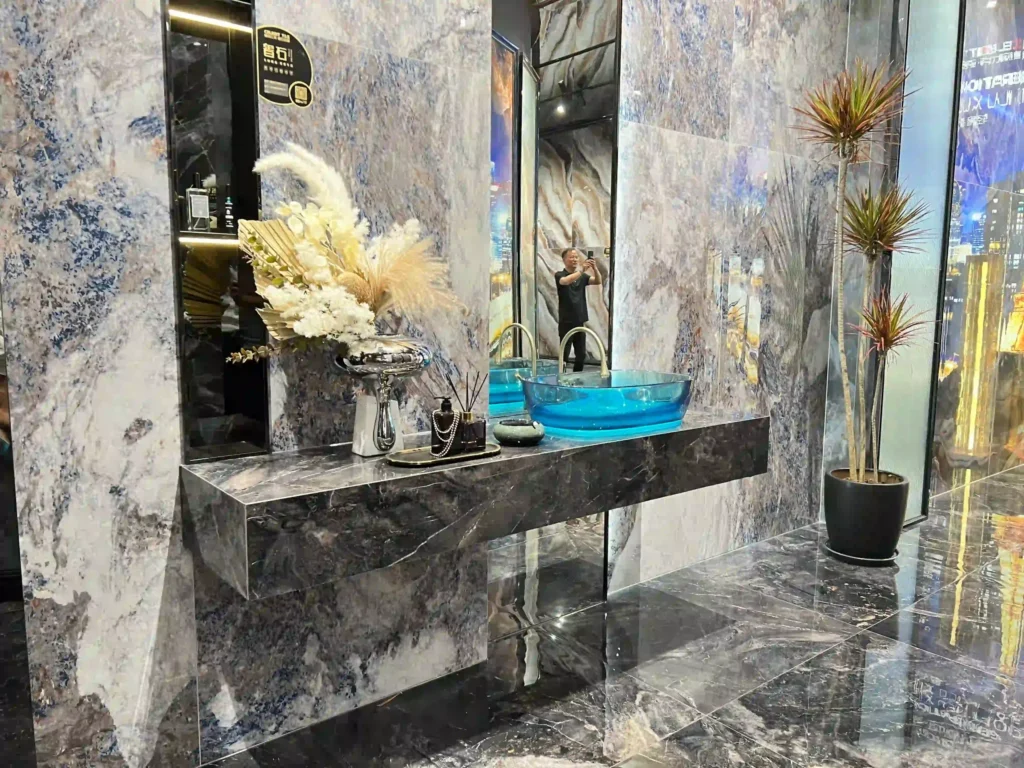

Framework for Making the In-House vs Outsourced Decision
Production volume serves as the primary decision factor. Manufacturers producing fewer than 10,000 units annually typically benefit from outsourced inspection services. The fixed costs of maintaining internal quality teams become prohibitive at lower volumes.
Technical complexity adds another layer. Bathroom product quality control requires understanding of hydraulic engineering, ceramic chemistry, and surface treatments. Building this expertise internally takes years and significant investment in both equipment and training.
Market diversification also influences the decision. Companies selling into multiple international markets need expertise across various certification standards. Outsourced providers typically maintain current knowledge across all major markets, while internal teams may struggle with less common regional requirements.
The optimal approach often combines both strategies. Many successful manufacturers maintain basic internal quality monitoring while outsourcing specialized testing and certification requirements to experienced providers.
In-House Quality Control – Building Internal Expertise for Bathroom Products
Building an internal quality control team for bathroom products represents a significant strategic decision that requires careful planning and substantial investment. Many manufacturers consider this option to gain better control over their production processes and reduce long-term inspection costs.
The advantages of in-house quality control bathroom products extend beyond simple cost savings. Internal teams develop deep product knowledge and can respond immediately to quality issues without waiting for external inspectors. This immediacy proves crucial when managing tight production schedules or addressing urgent customer concerns.
“Establishing internal quality control capabilities requires significant upfront investment but offers manufacturers greater control and faster response times for quality issues.”
Setting Up Internal QC Teams – Staffing and Training Requirements
Creating effective internal quality teams demands specific expertise that goes beyond general manufacturing knowledge. Quality control professionals need training in ceramic material science, hydraulic testing protocols, and international compliance standards. Most manufacturers underestimate the time required to develop this specialized knowledge.
Staffing requirements typically include a quality manager with ceramics experience, inspection technicians trained in bathroom product testing, and administrative support for documentation and reporting. Smaller operations might start with two qualified inspectors, while larger facilities require teams of six or more specialists.
Training costs often exceed initial estimates. Quality control standards for ceramics require understanding of glazing defects, structural integrity testing, and surface finish evaluation. New team members need six months of intensive training before achieving competency in bathroom product quality control protocols.
Essential Testing Equipment for Bathroom Product Inspection
Internal quality labs require specialized equipment that can cost between $150,000 and $500,000 depending on testing scope. Water pressure testing systems, impact resistance equipment, and drainage flow measurement tools represent the core requirements for toilet and basin inspection.
Calibration and maintenance add ongoing costs that many manufacturers overlook. Professional-grade testing equipment requires annual calibration services and regular maintenance contracts to ensure accurate results. These expenses can reach $50,000 annually for a fully equipped facility.
Internal QC Implementation Cost Analysis
| Cost Category | Initial Investment | Annual Operating Cost | Per Unit Cost (10K units) | Per Unit Cost (50K units) | Break-even Point |
|---|---|---|---|---|---|
| Testing Equipment | $300,000 | $45,000 | $34.50 | $6.90 | 18 months |
| Staff Salaries | $0 | $180,000 | $18.00 | $3.60 | Immediate |
| Training Programs | $25,000 | $8,000 | $3.30 | $0.66 | 6 months |
| Facility Setup | $75,000 | $12,000 | $8.70 | $1.74 | 12 months |
| Compliance Audits | $15,000 | $20,000 | $3.50 | $0.70 | 9 months |
Key Quality Control Tests – Drainage Efficiency and Impact Resistance
Drainage efficiency testing requires sophisticated flow measurement systems that simulate real-world usage conditions. Internal teams must master protocols for measuring water flow rates, waste removal efficiency, and rim wash effectiveness. These tests often reveal manufacturing inconsistencies that basic visual inspections miss.
Impact resistance testing presents another technical challenge. Proper testing requires controlled impact equipment and standardized testing protocols. Many internal teams struggle with consistency in impact testing, leading to false positives or missed defects. The learning curve for mastering these techniques can extend beyond a year.
Cost Analysis – Initial Investment vs Long-term Savings
When evaluating the pros and cons of in-house QC for bathroom products, volume becomes the determining factor. Manufacturers producing fewer than 25,000 units annually rarely achieve cost parity with outsourced inspection services. Fixed costs for equipment and staffing create high per-unit expenses at lower volumes.
Long-term savings become apparent only after reaching sufficient production scale. Large manufacturers report 30-40% cost reductions after the third year of internal quality operations. However, these savings assume consistent production volumes and effective team management.
Hidden costs often surprise manufacturers during implementation. Regulatory compliance audits, equipment upgrades, and staff turnover create unexpected expenses. Successful internal quality programs require contingency budgets of 20-25% above initial projections.
The decision to build internal capabilities works best for manufacturers with stable production volumes, technical expertise, and long-term growth plans. Companies managing multiple Chinese suppliers particularly benefit from faster response times and closer supplier relationships that internal teams enable.
Outsourced Quality Inspection – Leveraging Third-Party Expertise
Third-party inspection services offer manufacturers specialized expertise and objective quality assessment that internal teams often struggle to match. For bathroom product manufacturers, outsourced quality inspection bathroom manufacturers provides access to advanced testing capabilities without the substantial investment required for in-house facilities.
Professional inspection services bring years of experience testing thousands of bathroom products across multiple manufacturers. This breadth of exposure helps them identify potential issues that factory-based teams might overlook or dismiss as acceptable variations.
“Third-party inspection services provide objective quality assessment and specialized expertise that many manufacturers cannot economically develop internally.”
Types of Third-Party Inspection Services Available
Pre-production inspection services focus on raw material verification and initial production setup. These services examine ceramic slip composition, glazing materials, and mold conditions before mass production begins. Early intervention prevents costly quality issues from affecting entire production runs.
During production inspection (DUPRO) services monitor quality throughout the manufacturing process. Inspectors evaluate production consistency, identify trending quality issues, and verify that bathroom product quality control protocols remain effective as production scales up.
Final random inspection (FRI) represents the most common service type. These inspections use statistical sampling methods to evaluate finished products before shipment. Professional inspectors test drainage efficiency, impact resistance, and surface quality using standardized protocols that ensure consistency across different suppliers.
Factory Audit Process and Supplier Verification
Comprehensive factory audits evaluate manufacturing capabilities beyond simple quality control measures. Auditors assess production capacity, quality management systems, and compliance with international manufacturing standards. This assessment proves particularly valuable when qualifying new suppliers or expanding existing supplier relationships.
Supplier verification includes reviewing certifications, testing equipment calibration records, and quality management documentation. Many factories claim capabilities they cannot consistently deliver. Professional auditors can cut through marketing claims to assess actual manufacturing competence.
Third-Party Inspection Service Comparison
| Service Type | Cost per Inspection | Duration (days) | Detection Rate | Best Use Case | Compliance Coverage |
|---|---|---|---|---|---|
| Pre-Production | $800-1200 | 1-2 | 85% | New Suppliers | Material Standards |
| During Production | $600-900 | 1 | 78% | Large Orders | Process Control |
| Final Random | $400-700 | 1 | 92% | Standard Orders | Full Product Testing |
| Factory Audit | $1500-2500 | 2-3 | 95% | Supplier Qualification | System Certification |
| Loading Supervision | $300-500 | 0.5 | 88% | Export Shipments | Packaging Standards |
Shipment Inspection and Port-Based Quality Control
Loading supervision services ensure proper packaging and handling during shipment preparation. Inspectors verify product protection, container loading procedures, and documentation accuracy. Poor loading practices can damage products that passed all previous quality checks.
Container loading inspection includes checking moisture levels, securing methods, and space utilization. Professional supervisors understand how bathroom fixtures should be packaged to prevent damage during international shipping. Their expertise prevents costly insurance claims and customer complaints.
Port-based inspection services provide final quality verification before products leave the country of origin. This represents the last opportunity to address quality issues before products reach international customers.
Cost Structure and Service Level Agreements
Understanding how to improve quality control for bathroom fixtures through outsourced services requires clear cost analysis. Most inspection companies charge fixed fees per inspection day plus travel expenses. Volume discounts typically apply for manufacturers using multiple inspections monthly.
Service level agreements define response times, reporting formats, and quality standards. Professional inspection companies guarantee report delivery within 24-48 hours of completed inspection. Detailed reports include photographs, test results, and specific recommendations for addressing identified issues.
Compliance in bathroom product manufacturing often requires specialized knowledge of international standards. Third-party inspectors maintain current expertise across Watermark, CE, CUPC, and other certification requirements. This knowledge proves invaluable for manufacturers selling into multiple international markets.
The objectivity of third-party inspectors provides additional value beyond technical expertise. External inspectors have no vested interest in passing marginal products, unlike factory quality teams who may face pressure to minimize rejection rates. This independence ensures more reliable quality assessment.
Professional inspection services also provide scalability that internal teams cannot match. Manufacturers can increase or decrease inspection frequency based on production schedules without maintaining fixed staff costs during slower periods.
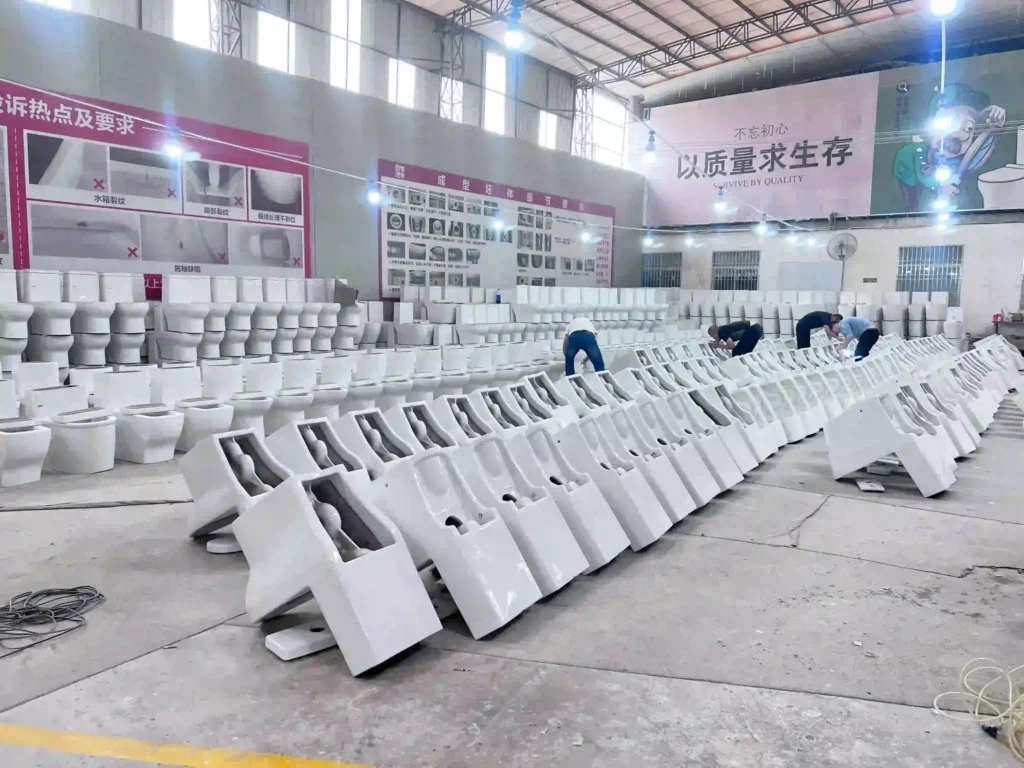

Comparative Analysis – Cost, Reliability, and Performance Metrics
Making informed decisions about bathroom product quality control requires comprehensive analysis beyond initial cost comparisons. Procurement managers must evaluate total ownership costs, quality outcomes, and operational efficiency to determine the optimal approach for their specific manufacturing requirements.
Real-world data from major projects, including our work with Emaar Properties, demonstrates significant performance differences between in-house and outsourced quality control approaches. These differences compound over time, making the initial strategic choice increasingly important for long-term business success.
“Total cost of ownership for quality control extends far beyond inspection fees, encompassing hidden costs that can dramatically impact overall profitability.”
Total Cost of Ownership Analysis – Hidden Costs and ROI
Hidden costs often determine the true financial impact of quality control decisions. In-house teams require ongoing training updates, equipment calibration, and facility maintenance that many manufacturers underestimate during initial planning. Annual hidden costs typically add 35-50% to projected internal quality control budgets.
Outsourced inspection services include hidden costs through travel delays, scheduling conflicts, and communication overhead. However, these costs remain variable and scale with production volume, unlike the fixed overhead of internal quality teams.
Return on investment calculations must consider quality failure costs. Poor bathroom product quality control can result in warranty claims, product recalls, and damaged customer relationships. Professional inspection services typically reduce these risks by 60-80% compared to basic factory quality control.
Performance Metrics Comparison – 5 Year Analysis
| Performance Factor | In-House QC | Outsourced Professional | Factory Basic QC | Industry Benchmark | Measurement Method |
|---|---|---|---|---|---|
| Total Cost per Unit | $15.20 | $8.50 | $4.20 | $11.30 | 5-Year TCO Analysis |
| Defect Detection Rate | 87% | 94% | 52% | 82% | Statistical Sampling |
| Customer Complaint Rate | 2.3% | 1.1% | 6.8% | 3.2% | Post-Sale Analysis |
| Compliance Pass Rate | 91% | 98% | 73% | 88% | Certification Audits |
| ROI Achievement Time | 28 months | 6 months | 3 months | 18 months | Payback Calculation |
Quality Reliability Metrics – Defect Rates and Consistency
Consistency in quality assurance in bathroom manufacturing separates professional approaches from basic factory inspection. Internal teams often show performance variation based on staff turnover, training levels, and workload pressure. Professional outsourced services maintain consistent standards through standardized protocols and regular audits.
Defect detection rates reveal significant differences between approaches. Factory-based quality control typically catches only 50-60% of significant defects, while professional inspection services achieve 90-95% detection rates. This difference translates directly into customer satisfaction and warranty costs.
The pros and cons of in-house QC for bathroom products become clearer when examining long-term reliability data. Internal teams require 18-24 months to achieve optimal performance levels, while outsourced services provide immediate access to experienced inspectors.
Lead Time Impact and Production Cycle Efficiency
Production scheduling flexibility differs significantly between quality control approaches. In-house teams provide immediate response capability but may lack specialized expertise for complex issues. This can lead to production delays when quality problems require expert consultation.
Outsourced inspection services typically require 2-3 days advance notice for scheduling but bring specialized knowledge that resolves quality issues more efficiently. The trade-off between immediate availability and expert problem-solving capability affects overall production cycle efficiency.
Quality control standards for ceramics often require specialized testing equipment that internal teams may not possess. Outsourced services maintain comprehensive testing capabilities that can handle complex drainage efficiency tests, impact resistance evaluation, and surface quality assessment without production delays.
Supplier Transparency and Relationship Management
Supplier relationships evolve differently under each quality control approach. Internal quality teams often develop close working relationships with suppliers, facilitating rapid communication and problem resolution. However, this closeness can sometimes compromise objectivity in quality assessment.
Third-party inspection services provide objective quality assessment that suppliers cannot influence through relationship building. This objectivity proves particularly valuable when getting down to brass tacks about quality issues that suppliers might otherwise minimize or dismiss.
At Seletti, we’ve observed that suppliers respond differently to internal versus external quality oversight. Professional inspection services often motivate suppliers to maintain higher quality standards because they cannot predict or influence inspection timing and criteria.
The optimal choice depends on production volume, technical complexity, and long-term strategic goals. Manufacturers producing over 50,000 units annually with stable product lines often benefit from internal quality control. Smaller manufacturers or those with diverse product portfolios typically achieve better results through professional outsourced services.
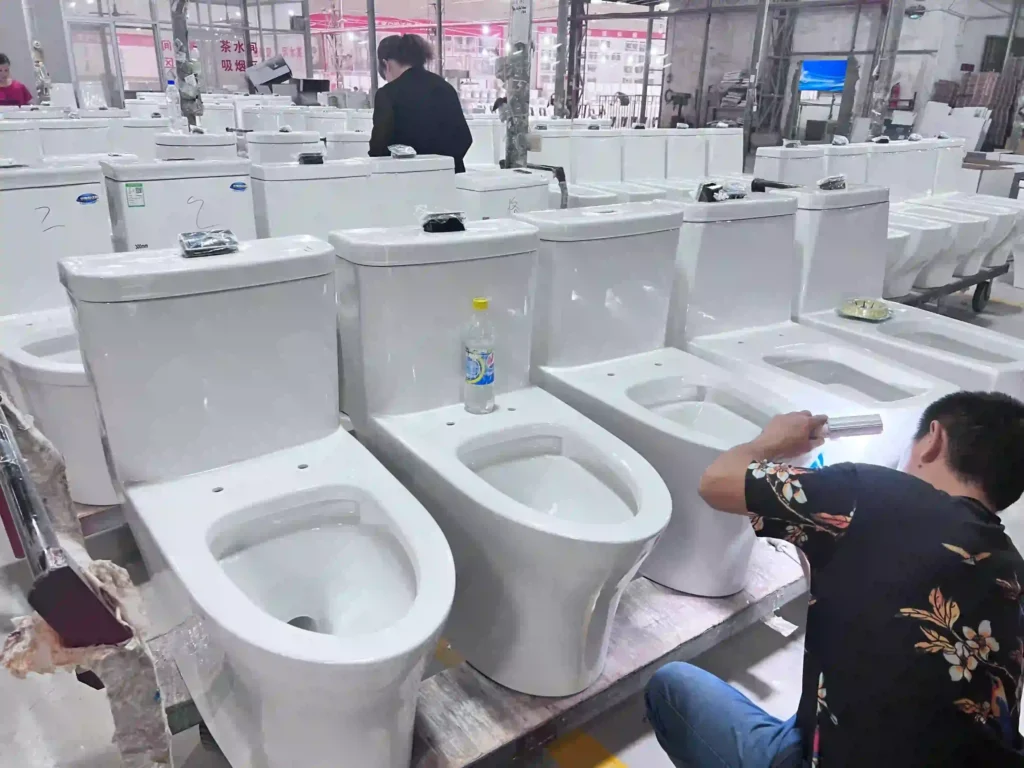

Making the Right Choice – Implementation Framework and Best Practices
Selecting the optimal quality control approach requires systematic evaluation of multiple factors specific to your manufacturing operation. The decision between in-house and outsourced inspection significantly impacts long-term business performance, making a structured decision framework essential for success.
Most successful manufacturers discover that the answer to “should manufacturers use in-house quality control or outsourced inspection?” depends on their unique combination of production volume, technical requirements, and strategic objectives rather than following industry-wide best practices.
“The most effective quality control strategies often combine elements of both in-house oversight and professional outsourced expertise, creating customized solutions that maximize efficiency while ensuring compliance.”
Decision Matrix – Factors for Choosing the Right Approach
Production volume serves as the primary decision factor, with manufacturers producing over 40,000 units annually typically benefiting from internal quality teams. Below this threshold, the fixed costs of equipment and staffing often exceed the benefits of direct control over quality processes.
Technical complexity adds another critical dimension. Simple ceramic products may require only basic inspection protocols, while complex bathroom fixtures with electronic components or specialized drainage systems demand advanced testing capabilities that favor professional quality inspection services for toilets.
Market requirements significantly influence the decision. Manufacturers selling into multiple international markets need expertise across various certification standards. Compliance in bathroom product manufacturing often requires specialized knowledge that internal teams struggle to maintain across all relevant standards.
Quality Control Decision Framework
| Decision Factor | In-House Advantage | Outsourced Advantage | Hybrid Opportunity | Weight Factor | Assessment Method |
|---|---|---|---|---|---|
| Annual Production Volume | >50K units | <25K units | 25K-50K units | 35% | Volume Analysis |
| Product Complexity | Standard designs | Custom/Technical | Mixed portfolio | 25% | Technical Assessment |
| Market Diversity | Single market | Multi-regional | Regional clusters | 20% | Compliance Mapping |
| Supplier Relationships | Few, stable | Many, variable | Mixed stability | 15% | Supplier Analysis |
| Budget Flexibility | Fixed costs preferred | Variable costs preferred | Balanced approach | 5% | Financial Analysis |
Hybrid Models – Combining In-House and Outsourced Elements
Many successful manufacturers implement hybrid approaches that leverage benefits from both strategies. Internal teams handle routine quality monitoring and supplier relationship management, while professional services conduct specialized testing and compliance verification.
A common hybrid model involves maintaining basic internal inspection capabilities for daily production monitoring while outsourcing complex testing requirements such as drainage efficiency, impact resistance, and certification compliance. This approach provides immediate quality oversight while ensuring access to specialized expertise.
Hybrid implementation often begins with outsourced services during the initial product development phase, gradually building internal capabilities as production volumes and expertise justify the investment. This evolutionary approach minimizes risk while building long-term quality management capabilities.
Implementation Timeline and Change Management
Successful quality control transitions require careful planning and phased implementation. Most manufacturers need 6-12 months to fully implement new quality control approaches, whether moving toward internal capabilities or establishing outsourced partnerships.
Change management becomes particularly important when transitioning from factory-based quality control to professional bathroom product quality control systems. Staff training, supplier communication, and customer expectation management all require coordinated attention during the transition period.
Implementation timelines should include buffer periods for unexpected challenges. Quality control system changes often reveal previously hidden production issues that require additional time and resources to resolve effectively.
Continuous Improvement and Quality Performance Monitoring
Effective quality control systems require ongoing monitoring and improvement regardless of the chosen approach. Key performance indicators should include defect detection rates, customer complaint frequencies, and compliance audit results measured consistently over time.
Regular performance reviews help identify opportunities for optimization. Many manufacturers discover that their optimal quality control approach evolves as production volumes change, product complexity increases, or market requirements shift. Flexibility to adapt approaches becomes a competitive advantage.
At Seletti, our one-stop solution approach demonstrates how strategic partnerships can provide comprehensive quality control without the complexity of managing multiple service providers. By integrating sourcing, AQL inspections, and logistics under unified management, we help clients like Emaar Properties achieve consistent quality outcomes while keeping things simple and cost-effective.
The most successful manufacturers view quality control as an evolving capability rather than a fixed decision. Regular assessment of performance metrics, cost efficiency, and market requirements ensures that quality control strategies remain aligned with business objectives and customer expectations.
Featured image suggestion: Professional consultation meeting showing quality control decision-making process with charts, metrics, and strategic planning materials displayed on conference table.
Conclusion
After working in bathroom product sourcing for years, I’ve seen manufacturers struggle with this exact decision—and honestly, there’s no universal answer. The choice between in-house and outsourced quality control comes down to your production volume, technical expertise, and long-term goals rather than following what everyone else does.
From my experience at Seletti, the most successful clients are those who match their quality control strategy to their actual business needs. Small to medium importers typically benefit from professional inspection services that provide specialized expertise without the massive overhead. Larger manufacturers with consistent volumes can justify building internal capabilities, but they need to commit fully to the investment in equipment, training, and ongoing development.
The key insight I’ve learned is that quality control isn’t just about catching defects—it’s about protecting your brand reputation and maintaining customer trust. Whether you choose internal teams, outsourced professionals, or a hybrid approach, consistency and expertise matter more than the specific method. Getting quality right from the start is always a **”no-brainer”** compared to dealing with costly returns and damaged relationships later.
FAQ
Q1: What are the benefits of in-house quality control for bathroom products?
A1: In-house quality control allows manufacturers to enforce strict compliance with internal standards, enhancing product reliability and facilitating immediate decision-making in response to defects.
Q2: How does outsourced quality control differ from in-house?
A2: Outsourced quality control typically reduces labor costs and improves expertise through specialized inspectors, but may lack the immediate response capabilities of in-house teams.
Q3: What should manufacturers consider when choosing between in-house and outsourced QC?
A3: Factors include cost efficiency, the scale of production, the complexity of products, and the desired level of control over quality assurance processes.
Q4: What role does supplier transparency play in quality control for bathroom products?
A4: Supplier transparency builds trust, enables real-time monitoring of production standards, and facilitates better quality compliance across the supply chain.
Q5: What are common defects found in bathroom products during quality inspections?
A5: Common defects include surface imperfections, leaks, and non-compliance with safety or performance standards, which can be critically assessed through both in-house and outsourced inspections.
Q6: How can manufacturers improve quality control for bathroom fixtures?
A6: Implementing thorough inspection protocols, utilizing advanced testing technologies, and promoting feedback loops between production and QC teams can significantly enhance quality control processes.
Q7: What certifications should bathroom products have to ensure quality?
A7: Certifications like Watermark, CUPC, and CE are vital as they indicate compliance with safety and performance standards required in various markets.
Q8: What kinds of testing are performed on bathroom products during quality control?
A8: Testing may include size verification, glaze inspection, water-seal testing, function tests, and stress assessments to ensure durability and compliance with quality standards.
External Links
- The Importance of Quality Control in Bathroom Product Production
- Bathroom Quality Control Checklist
- Quality Control Guide for Ceramic Bathroom Sanitary Ware
- Bathroom Accessories Inspection Protocols
- Quality Control in Bathroom Vanity Wholesale Ensuring Product Excellence
- How to Ensure High Quality in Bathroom Product Manufacturing
- Bathroom Hardware Quality Inspection Standard and Checklist
- Plumbing Products Testing and Certification to Code Compliance

